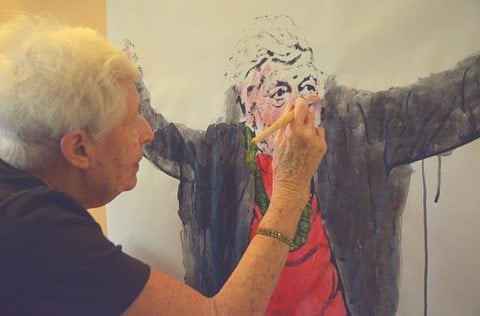
Arts and science combine for dementia care
A new study looking at the benefits of visual art activities for people living with dementia should provide the evidence that decision-makers need, say Teri Howson-Griffiths and Gill Windle.
The benefits of using the arts with people living with dementia often seem obvious to artists and organisations, many of whom have been working in the field for numerous years. Funding for these activities habitually requires justification with evidence of benefits, but this often proves difficult to obtain.
A more positive picture has started to emerge in arts and health, with specific research on arts and dementia care providing much sought-after evidence of the benefits that creative projects can bring to people living with dementia.
While it can be difficult to understand the potential benefits before joining, once people started attending, in the main they found it an enjoyable experience
This growing body of evidence has the potential to inform policy and practice. It can ensure that funding continues to support these types of projects, which focus on the individual and what they are still able to enjoy doing. For many people living with dementia they have become an important means of social contact and cognitive stimulation.
Visual arts study
Dementia and Imagination was a three-year study funded by the Arts and Humanities Research Council and Economic and Social Research Council, and led by the Dementia Services Development Centre at Bangor University. The research has brought together a number of partners including artists, arts organisations, academics from diverse research fields and third-sector organisations.
The main aim of the project was to explore the impact of visual arts activities on people living with dementia, their relatives and care staff, and the communities where they lived. As part of this, we recruited people living with dementia to take part in 12 weeks of art viewing and art-making activities.
These were delivered in three distinct settings: care homes in the north-east of England, art galleries and cultural spaces in north Wales, and within the NHS in assessment wards or day centres in central England. In total, 11 art groups took place involving 125 people living with dementia and 146 relatives and care staff, making it one of the largest funded visual arts studies of its kind.
Early outcomes
The published findings will be announced in the next year, but there are some early positive outcomes. An observation tool focusing on ‘in the moment’ responses in the art activity, and completed by researchers during the art sessions, showed a positive increase in areas such as attention, pleasure, interest and self-esteem, and decreased sadness and negative effects.
Interviews conducted with participants also supported this, highlighting that, while it can be difficult to understand the potential benefits before joining, once people started attending, in the main they found it an enjoyable experience. One male participant commented: “It's quite something really. It's very soothing to take part in something. You feel you are achieving something. It's not completely gone, your mind's not completely gone. There are some things I can still do and still take part.”
Using a Social Return on Investment method (SROI), the health economists found the visual arts programme was good value for money. Recognising the value generated in terms of improving people’s wellbeing is an important consideration for those who may fund similar activities in the future.
Other findings suggest there was also a positive impact on staff and family members, an indirect benefit beyond the individuals with dementia taking part. For staff, they perceived they had greater knowledge about their residents and their interests. One member of care staff commented: “We never knew about the resident’s grandmother in the garden. And it wasn’t until they produced a picture and then we started to copy these pictures on to paper, that she comes out with this – her gran had this beautiful garden.”
Government commitment
Now the election is over, it’s inevitable that minds will turn to how the result might affect the arts and support quality of life to help people living with dementia live as well as possible. A continued pledge of focus on dementia would be welcomed by many, for an area often neglected in the past and only recently gaining traction in the media and across UK industry.
In 2016, the All Parliamentary Group for Arts, Health and Wellbeing met with a number of practitioners and researchers, looking to raise awareness and support for these types of activities so that we not only think of developing medicines and cures, but focus on creative ways of delivering good quality, stimulating care.
By offering them an evidence base to back up their experience that the arts can boost the wellbeing of people living with dementia, we hope our findings will encourage artists and organisations to take their work forward.
Teri Howson-Griffiths is a Theatre Practitioner and Lecturer in Drama at Liverpool John Moores University and Gill Windle is a Senior Researcher in Gerontology at Bangor University.
Dementiaandimagination.org.uk
A free handbook developed from the research is available.
Twitter: @dem_imag
Join the Discussion
You must be logged in to post a comment.